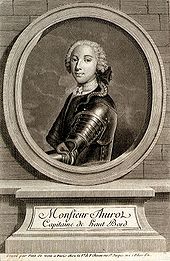François Thurot
François Thurot (born July 22, 1727 in Nuits-Saint-Georges ( France ), † February 28, 1760 at sea near the Isle of Man , Great Britain ) was a French naval officer and privateer .
Life
François Thurot was born in Nuits-Saint-Georges in Burgundy as the son of a landlord. His grandfather is said to have been Irish and came to France as a soldier in the Irish Brigade . Raised by the Jesuits in Dijon , he trained as a pharmacist and came to work as a surgeon on a privateer ship in 1744 during the War of the Austrian Succession . He became a British prisoner of war but was able to escape. He then joined the crew of a privateer ship from Saint Malo as a simple seaman and quickly served himself up to become pilot and captain . He achieved further success as the captain of a privateer equipped by merchants from Dunkirk . After the end of the war he worked as the captain of a merchant ship, is said to have been involved in smuggling business and lived in London for some time .
Due to his success as a privateer captain, Thurot received an officer's license in the French Navy in 1755, shortly before the outbreak of the Seven Years' War . First he commanded the Corvette Friponne with great success , and from 1757 the frigate Maréchal de Belleisle (36, later 44 cannons). With these he undertook, partly in association with other ships, several pirate trips, during which he took numerous British merchant ships. He avoided opposing warships here, since his task was the pirate war against British sea trade; he broke off a battle with the frigate HMS Southampton (32 cannons), although he had two nominally superior ships with the Maréchal de Belleisle and the Chauvelin (36 cannons). As a commodore , in 1759 he led an association of six frigates and corvettes with which he was supposed to bring 1,300 soldiers under Brigadier General de Flobert to Ireland for a landing operation . In October 1759 he managed to leave Dunkirk after the blocking British squadron had been driven out by a storm. Although three of the ships had to return to France, the French managed to make a landing in February 1760 and force the weak garrison of Carrickfergus in what is now Northern Ireland to surrender. But the French unit was sighted on February 28 at the Copeland Islands by the three British frigates HMS Aeolus (32 guns), HMS Pallas (36 guns) and HMS Brilliant and after a pursuit in the direction of the Isle of Man, they were put to battle. While the Blonde (36 cannons) and the Terpsichore (24 cannons) surrendered to the British without much resistance, Thurot and his flagship Maréchal de Belleisle offered bitter resistance and fell in battle. His badly damaged ship also had to drop the flag. According to the report of a contemporary witness, it looked like a slaughterhouse; no fewer than 200 men are said to have been killed or wounded by the crew. Thurot himself appears to have been killed at the start of the battle. His body was washed ashore in Ireland and buried in Kirkmaiden Cemetery, Galloway .
Thurot was considered one of the most daring French privateers of his time. At the same time, he was held in high regard by his enemies because of his chivalry. The British naval historian William Laird Clowes praised him as a man "who never turned a blind eye to the principles of honor, generosity and humanity in his methods of warfare and was therefore hardly less mourned by his British opponents than by his compatriots."
literature
- William Laird Clowes: The Royal Navy. A History from the Earliest Times to 1900, Vol. 3, London 1996 (reprint of the 1898 edition)
- GVC Young: Captain Francois Thurot: Privateer, Agent Extraordinaire, Smuggler, Saboteur-elect and Naval Officer, Peel 1986
Web links
- Francois Thurot (1727-1760) and his Naval Engagement off the Isle of Man
- Defeat and Funeral of Thurot
- Notice Respecting Francois Thurot, a French Naval Officer, Buried at Kirkmaiden, Wigtonshire, in the year 1760. By George Corsane Cuninghame, Esq. (PDF file; 220 kB)
| personal data | |
|---|---|
| SURNAME | Thurot, François |
| BRIEF DESCRIPTION | French naval officer and privateer |
| DATE OF BIRTH | July 22, 1727 |
| PLACE OF BIRTH | Nuits-Saint-Georges |
| DATE OF DEATH | February 28, 1760 |
| Place of death | at sea off the Isle of Man |
